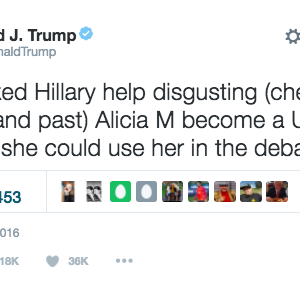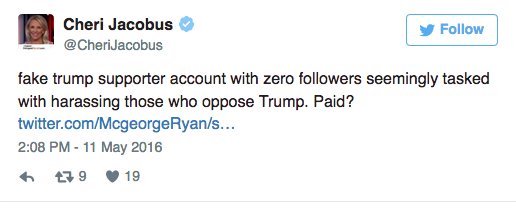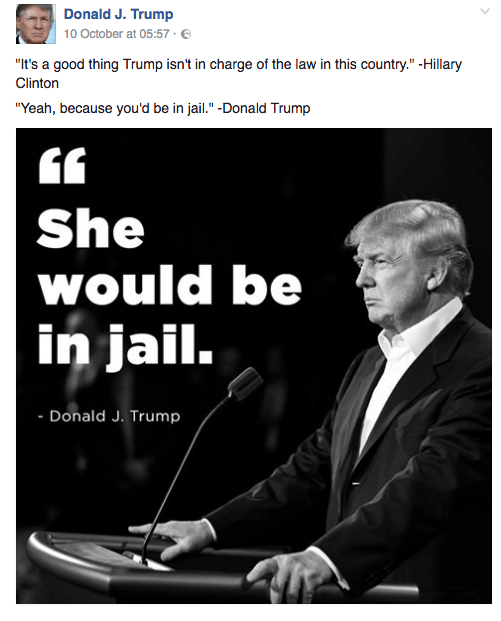This story is the latest in our paramedia series, Read it all here. -Ed.
aNewDomain — The key to his success was in his mastery of the medium.
I’m talking about Franklin D. Roosevelt. In his 1932 campaign against incumbent US President Herbert Hoover, Roosevelt was king of the airwaves. Over millions of American living room radio sets, he lambasted Hoover for “having no real response” to The Great Depression, and pushed his own Depression cure-all, the New Deal, instead.
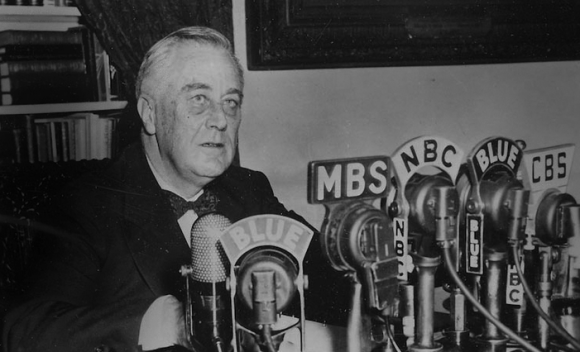 Americans believed. And FDR won the White House in a landslide.
Americans believed. And FDR won the White House in a landslide.
Twenty years later, Gen. Dwight Eisenhower did the same with TV, which had just penetrated the majority of US households for the very first time.
A notoriously weak public speaker, Eisenhower’s TV ads — “Man from Abilene” and “I Like Ike” — used video editing, imagery and catchy tunes to make up for his short fall. He won, too.
It’s a time-worn rule: Whoever masters the latest electronic medium wins the election.
Take John F. Kennedy. Telegenic and relaxed, he dominated the first televised presidential debates in 1960, making Richard M. Nixon look like a sweaty, nervous Nellie by comparison. And Ronald Reagan, 20 years later, blended his own telegenic persona with 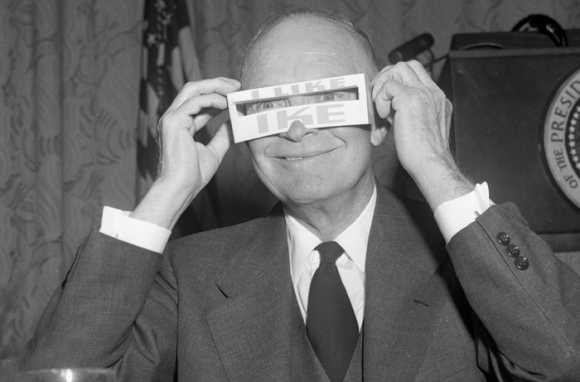 cutting edge satellite tech, making his face and pre-taped presence ubiquitous among countless GOP election rallies and fundraisers. Donor minds were blown.
cutting edge satellite tech, making his face and pre-taped presence ubiquitous among countless GOP election rallies and fundraisers. Donor minds were blown.
As for Barack Obama, he used the nascent online communities of the time to raise funds and awareness during the 2008 election.
But it was only when a supporter posted a sexy video called Crush on Obama on a new medium called YouTube that the world suddenly understood just how effective digital community outreach could be.
Crush on Obama was one of the first ever viral videos, and is today considered one of the biggest memes of the 00s decade.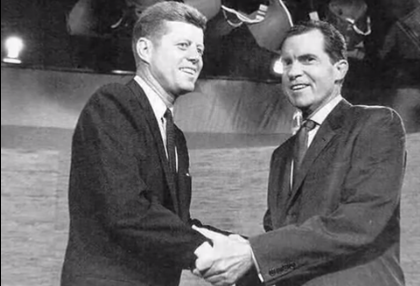
Scroll down to the bottom of this post to watch all the videos mentioned above. Ed.
How Trump Trumped Them All
He emerged as the master of social media fairly early in the presidential campaign. It wasn’t that Trump used social media. It was how.
From the beginning, Trump seemed to intuitively grasp the value of controversy, no matter how negative or how nutty. Study the social trends around Trump and that’s the first thing you’ll notice.
Each outlandish Trump episode and outburst seemed to land him more social power than he had before.
In this, the former reality TV star took a critical cue from Kanye West, whose social following famously ballooned after he began having epic meltdowns on Twitter.
Trump got what Clinton missed: That on social, mentions, likes and shares — that is, pure attention –matter far more than actual content. That, to win the hearts and minds on the social nets, it’s more important to entertain than to inform.
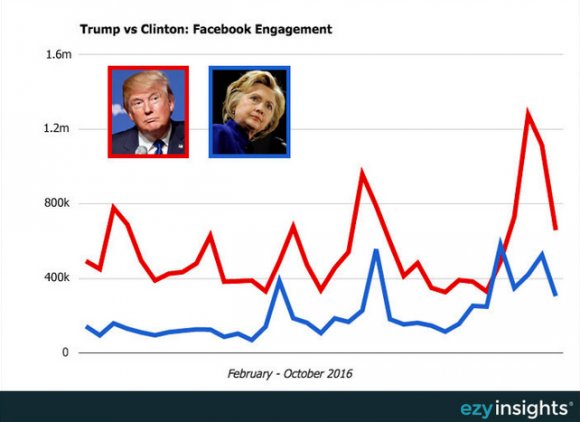
Early in the campaign, Trump wondered aloud about why controversy wouldn’t get him votes, when it got him likes and followers?
Wouldn’t that work, he wondered?
The answer to that question, as his social strategists soon discovered, was yes. Hell, yes.
You might wonder why this is. The answer has to do with the fast, short format of social media. Think about it. When you dive into social media, you necessarily dumb down. There’s no need to maintain any kind of an attention span. No one even can stand to sit through an eight-second video on social. Things fly by, and you fly with them. Yes, you get the top line details on pretty much everything. But the point, for most people, is not just to get informed, but to share, like, retweet and reply.
The end game: To win more followers, make a point, argue down a view or spout your own. And to feel like you belong.
The Trump campaign’s social strategy worked with you on all those motivations. It satisfied by arming you with voluminous, often explosive content you could react to and share.
But it was the Trump campaign’s choice of what to share in these brief, micro opportunities to reach Americans on social that was especially crafty. The Trump campaign’s social stream never had anything to do with facts, figures, policies and so on.
It was more about providing National Enquirer-like stories, conspiracy theories and far-fetched angles on issues that social audiences would otherwise find boring. And hundreds of alt-right sites spent the entire campaign cycle pushing out such content, which scores of Trump bots, supporters and Trump himself shared again and again.
Combined with Trump’s unpredictable antics and late night Twitter rants, the fake news that streamed out of the campaign and its supporters proved devastating to Hillary Clinton.
Conspiracy Theories, Fake News and Innuendo
With over 250k mentions on Twitter a day, we all became addicted to reading and interacting with the steady stream of outrageous statements, conspiracy theories and semi-ridiculous fake news and assertions Trump, his supporters and the pro-Trump social bots spit out.
Like a dorky reality show where contestants rely on shock, insult and innuendo to beat the others, watching the whole thing unfold was unbelievably addictive. We all clicked and shared too much. That’s how we fueled his campaign.
One of the most brilliant things about Trump’s social strategy is that it seemed to recognize the addictive quality of Trump’s tweets and posts. And it kept us addicted, just by steadily pumping up the volume.
Trump’s social strategists, knowing that addicts need more and more of a drug to get high, kept pushing this sort of material. The social crowd on both sides sucked it all up.
It wasn’t about the media, as Marshall McLuhan once said. It was the message.
No, Clinton campaign chair John Podesta didn’t practice witchcraft or “spirit cooking,” no many how many times people shared that.
And no, Clinton didn’t pay Trump protesters who responded to a Craig’s List ad $3,500 a pop. Nor did she personally sell a quarter of the nation’s Uranium to China. And last week’s story that an FBI agent who’d investigated Clinton was found dead in a double-suicide and fire in Denver? Fake, fake, Fake.
But these made-up facts were shared and liked and retweeted tens of millions of times, and ended up almost as good as the truth to millions of Trump supporters on social.
An astounding example of how even an obviously fake news piece can rise to truthiness unfolded last fall.
It all started in October 2015, when a headline ran on the humor site, RealNewsRightNow, claiming that the US State Department was planning to bring 250,000 Syrian refugees to Navajo lands in Arizona.
It was a joke. The story ran alongside another joke story, which was headlined “Vatican City Conducts ‘Successful’ Nuclear Test.”
But two weeks later, Hannity — who, remember, is on Trump’s payroll — repeated the fictional headline about the refugees, as fact, on Fox.
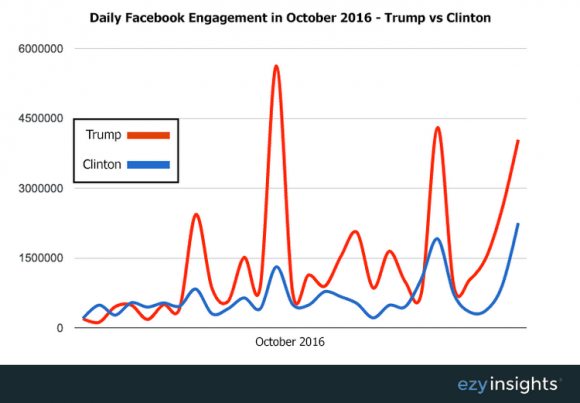 Then, Hannity reported the details of the fake news st0ry on his own show to Trump, who was a guest. Once again, as fact.
Then, Hannity reported the details of the fake news st0ry on his own show to Trump, who was a guest. Once again, as fact.
Trump used the fake Syrian refugee news to explain why Americans should fear immigration, in an interview with Today’s Matt Lauer eight days later. The network in turn covered this ridiculous story as if it were true.
Trump’s rival Republican primary candidates, Ben Carson and the former Hewlett Packard CEO, Carly Fiorina, each repeated the same bogus statistics in the most fiery of terms.
Even though The Washington Post debunked the fake Syrian immigrant story three times, and every major fact checking site, including FAIR, Politifact, MediaMatters, FactCheck.org and Snopes, had, too, the story spread like Malaria.
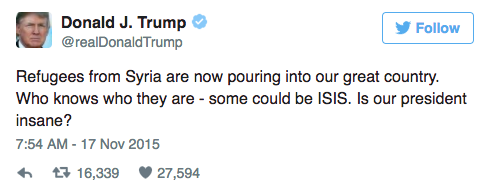 And Trump kept repeating the fictional stat as truth on Twitter and Facebook for a long time afterward. After millions of shares, likes and retweets, it became a monster.
And Trump kept repeating the fictional stat as truth on Twitter and Facebook for a long time afterward. After millions of shares, likes and retweets, it became a monster.
The fake news story was just a jumping off point, which Trump and his fans could pull out anytime they needed data, even fake data, to show how Clinton, Obama and other Democrats’ immigration policies had gone so terribly wrong.
Free Marketing, Benefits and Bots. Lots of Bots.
And look at these numbers: According to a report on CNBC: On Sept. 26, 2016, the night of the first presidential debate, Trump dominated Facebook, owning 79 percent of the conversation that evening. And on Twitter, he dominated 62 percent of the conversation.
Not incidentally, that night marked the first time in history that Facebook and Twitter live streamed a presidential debate.
The free marketing all this social traffic afforded Trump was, in a word, priceless.
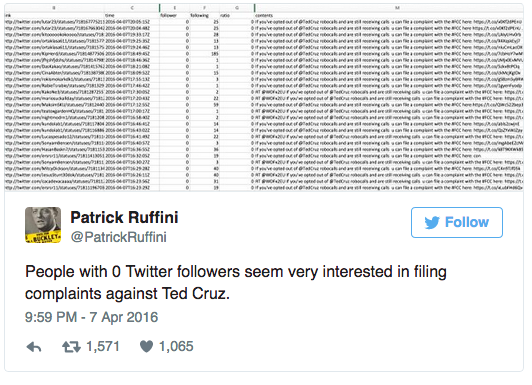 Another factor that helped Trump intensely on the social front: bots.
Another factor that helped Trump intensely on the social front: bots.
In his research, Echelon Insights’ digital analytics consultant Patrick Ruffini uncovered more than 465 fake pro-Trump accounts on Twitter last spring. All had zero followers and tweeted with more or less the same message at the very same time, several times daily and all night long.
The Meme Game
It wasn’t all witchcraft, though. Trump used social to constantly ram home short, memorable slogans and memes that were ideal for social sharing. Phrases like “build the wall,” “drain the swamp” and, of course, “make America great again,” which later became just as instantly recognizable as #MAGA. Together, these little slogans became the “Where’s the Beef?” of the 2016 campaign, times a zillion.
just as instantly recognizable as #MAGA. Together, these little slogans became the “Where’s the Beef?” of the 2016 campaign, times a zillion.
A deeper look at the stats reveals a “modern, dynamic social strategy,” according to an in-depth analysis by EZYinsight into the Trump campaign’s Facebook strategy. According to its research, which focused on October 2016, the Trump social secret sauce was in upping content creation at the times when user engagement was highest. The researchers continue:
“This sort of strategy is used by experienced news and viral publishers around the world. During a big, newsworthy event, be it Eurovision, a Royal wedding, or any particular incident in which public interest peaks, publishers in the know about Facebook algorithm(s) will increase the number of posts they make.
“This makes sense when you imagine that the total amount of engagement available to be claimed each day is variable,” according to the researchers. “During periods of high interest, people are ‘glued to their seats’ or whatever the modern equivalent is. Thus the amount of total available engagement increases – people are using Facebook more, liking, commenting and sharing more.”
the researchers. “During periods of high interest, people are ‘glued to their seats’ or whatever the modern equivalent is. Thus the amount of total available engagement increases – people are using Facebook more, liking, commenting and sharing more.”
Trump’s social team seems to be keenly clued in to this sophisticated media marketing technique, said the EzyInsights researchers, who added:
“You can see very clear peaks representing high posting frequency on three specific dates: the 7th, 12th and 22nd of October. Do these peaks of output correlate with higher total engagement on those days? You bet they do.”
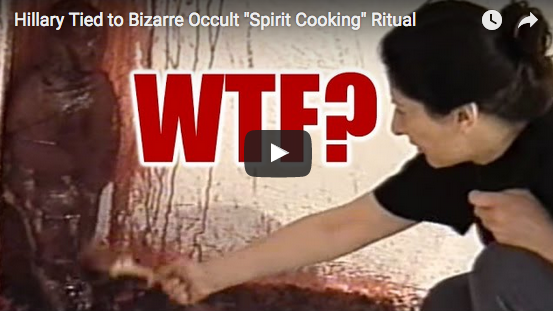 Now consider campaign funding. By late October, Clinton’s campaign had spent about $141.7 million on ads, compared with Trump’s $58.8 million.
Now consider campaign funding. By late October, Clinton’s campaign had spent about $141.7 million on ads, compared with Trump’s $58.8 million.
How did he get away with this? By becoming loud, clickable, controversial and viral. By using social media the way media does, as we’ve seen, and posting more on high-engagement days.
It worked on Facebook. And it worked eerily well on Twitter.
Evil genius?
Add all this up, and it’s hard to deny: This is the stuff of genius.
Sometimes this gives me hope, hope that this kind of genius might possibly help Trump figure out how to right himself and become a better man than we saw on the campaign trail.
Someone who will fight for the rights of all Americans, and set aside the petty racial, religious, cultural and gender prejudices that characterized his campaign.
Check out the videos we gathered for you, below.
From the silent film footage of the Democratic National Convention in 1928 to FDR’s 1932 radio appearances, Dwight Eisenhower’s pioneering TV ads in 1952, Kennedy’s telegenic TV debate appearances and ads in 1960 to Obama’s 2008 campaign’s YouTube efforts, here’s how the use of new media has defined almost a century of US presidential winners.
First, check out this footage from 1928 Democratic National Convention in Houston, featuring Democratic nominees Al Smith and Joe Robinson. The silent film below also contains footage of US President Woodrow Wilson, 1924 nominee John W. Davis and William Jennings Bryan.
Here’s FDR on the campaign trail against Hoover in 1932.
Now fast forward 20 years to 1952, a time when television had penetrated a majority of American households for the first time. That was the year presidential candidate Gen. Dwight D. Eisenhower pioneered the TV campaign ad. The political ad for Eisenhower, below, as well as the famously catchy “I Like Ad” commercial below that, were produced by Walt Disney’s brother, Roy Disney.
Also in 1952, this Eisenhower TV ad made the “I like Ike” slogan into something Americans instantly recognized, through a jaunty cartoon and a catchy jingle. It’s another Roy Disney production.
Just eight years later, a telegenic John F. Kennedy appeared in the below TV campaign ad, which featured his friend, the superstar vocalist Frank Sinatra singing a campaign-adapted version of “High Hopes.” Slick.
During Barack Obama’s campaign, this video, debuting on a young YouTube, became one of the top memes of the decade. Crush on Obama went viral. The campaign didn’t fund its protection, but in exploiting the early medium, it laid the groundwork for a community to build around him there. A must-see.
Here’s Will.i.am’s 2008 Barack Obama campaign music video, “Yes We Can.”
Crush on Obama. Named one of the top 10 memes of the decade, Crush on Obama went viral almost after hitting embryonic YouTube in 2007. The Obama campaign maintains it had nothing to do with the video, but many doubt it. To see why, watch it below.
Here’s Will.i.am’s 2008 Barack Obama campaign music video, “Yes We Can.”
Cover image: TheHustle.com, All Rights Reserved.


